The P-8, Singapore & South China Sea Strategy
Posted on
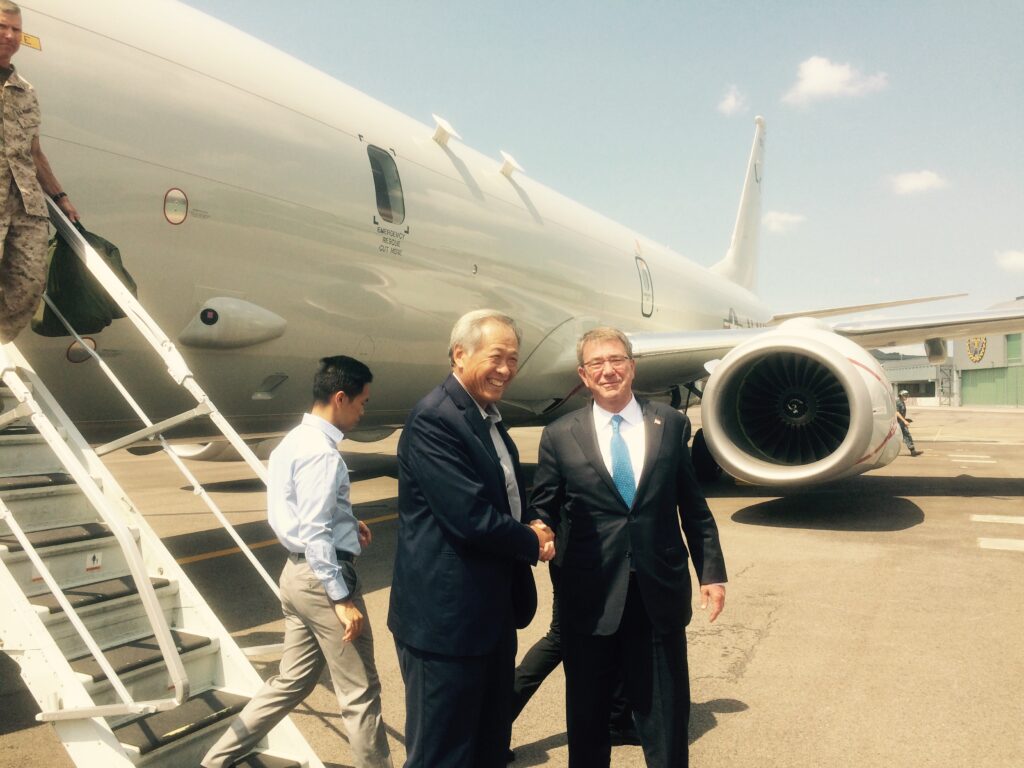
Singaporean Defense Minister Ng Eng Hen and US Defense Secretary Ash Carter pose in front of a US Navy P-8 Poseidon operating from Singapore.
OVER THE MALACCA STRAIT: Defense Secretary Ashton Carter and his host, Singaporean Defense Minister Ng Eng Hen, made a stark and clear statement to China before the Shangri-La summit began, boarding America’s preeminent sub-hunting and surveillance plane, the P-8 Poseidon.
“How do you like this aircraft?” asked Carter as they boarded the P-8.
“I love this aircraft!” replied Lt. Torrey Plum.
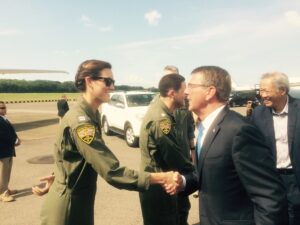
US Navy Lt. Torrey Plum greets Defense Secretary Ashton Carter before he and Singaporean defence minister Ng Eng Hen (right) board her P-8.
Plum isn’t alone in her enthusiasm for the Boeing-built aircraft. It’s a sentiment shared at high levels of the US, Australian, British, and Indian militaries, all of which are fielding the surveillance plane.
The P-8 is one of the Navy’s newest aircraft; Lt. Plum’s is just two years old. That it’s being deployed first to the Pacific, before it goes to any other region overseas, is often cited by defense officials and admirals as tangible evidence that the much-questioned “rebalance to Asia” is real.
Strategists are particularly excited to have the P-8 flying out of Singapore, which agreed in September to host regular deployments. (There is not a permanent US base, but that’s increasingly the model for our not-technically-alliances in Asia). The long-range, cutting-edge maritime patrol plane operating out of one of the world’s great hubs of maritime traffic is a happy marriage of technology and geography — though not so happy for the Chinese.
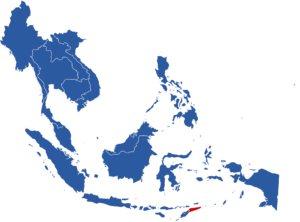
Association of Southeast Asian Nations (ASEAN) member states.
The Tyranny of Geography
Geography first. The region is “a superhighway for supertankers,” Secretary Carter told reporters on his own aircraft en route to Singapore.
“We flew over the Strait of Malacca,” Carter said later, after the P-8 flight, “which is always miraculous for me to see — just the density of international shipping, flags from all countries, all sorts of origins, all sorts of destinations — a great sign of the global commons at work that we try to protect with our militaries.”
“There’s no country and no geography in the world that compares to Singapore,” Carter said at the post-flight press conference at Paya Lebar Airbase.
Singapore is the strategically situated spear-point of the Malay Peninsula, which stabs south from the Asian mainland into the Indonesian archipelago. The shortest pathway through this maze of land and water runs right past Singapore through the Strait of Malacca. Eastward through the strait flows almost all the fuel that powers the mighty economies of South Korea, Japan, and China. Their factories burn the fuel and make the goods that flow westward to the Middle East, India, Africa, and Europe in return.
The P-8 deployment “underscores our shared belief that the waters around this region are critical,” Ng said, speaking alongside Carter at the airbase. “13 million barrels of oil flow through the Strait of Malacca, second only to the Strait of Hormuz…. Any instability in this critical sea line of communication has enormous impact not only on the economies in ASEAN (Association of South East Asian Nations) but globally.”
Not too many years ago, Ng said, Lloyd’s of London raised insurance premiums in the strait because of rising piracy. The regional nations agreed at the 2005 Shangri-la Dialogue to crack down, with the US and other interested outsiders pledging support. After the institution of joint patrols in the air and on the sea, Ng recounted, the high-risk premium was removed.
Such collaboration to secure the seaborne lifelines is in all countries’ interest, including China’s. “It’s not directed at anyone, including China,” Carter said. “It is inclusive of everyone, including China.”
But not every operation is so uncontroversial. Besides tankers, merchant ships and fishing boats, Chinese warships and submarines also ply these waters, operating out of heavily militarized Hainan Island. Hainan is the home base for China’s expansion into the South China Sea, and its new fake island bases there in turn form Hainan’s outer perimeter. So sensitive is Hainan that Beijing objects to, and often intercepts, US forces coming anywhere near it. It objects especially to long-range surveillance aircraft with high-tech sensors — aircraft such as the P-8.
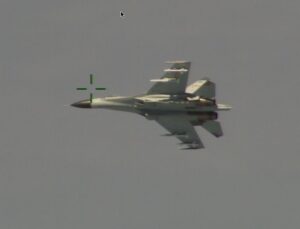
A Chinese Navy J-11 fighter buzzes a US P-8 Poseidon surveillance plane off Hainan Island in August 2014.
The P-8 In Action
“The Chinese don’t like the idea of a capable search aircraft being in the region,” said Bryan Clark, a retired Navy commander and former senior aide to the Chief of Naval Operations, now with the Center for Strategic & Budgetary Assessments. Operating from strategic locations such as Singapore, he said, P-8 “will be able to monitor and record their actions on the surface of the water, such as those being taken against China’s South China Sea neighbors in the Philippines and Vietnam. They also may be concerned the P-8 is conducting surveillance against submarines operating out of Hainan Island.”
In fact, in addition to reconnaissance, the P-8 also specializes in anti-submarine warfare (ASW). It can drop both floating sonars (sonobuoys) — of which it carries twice as many as its 1960s-vintage predecessor, the P-3 Orion — and guided torpedoes. While it currently shares the same sonar processor as the old P-3, it’s being upgraded with a new and more powerful one to better find submarines. It already has a superior periscope and radar for finding surface ships, as well as racks for Harpoon missiles to sink them.
The P-8 could also accommodate sophisticated electronic sensors, Clark said, which would allow it to locate radar sites and eavesdrop on radio nets — making it a superior version of the venerable EP-3. Considering the Chinese once intercepted an EP-3 off Hainan so aggressively that their fighter and the US plane collided, downing both, they’d hardly welcome what’s effectively an EP-8 flying out of nearby Singapore.
A P-3 or EP-3 flying out of Singapore, by contrast, wouldn’t be quite as worrisome for China. The older aircraft are propeller-driven and lack the capacity to refuel in-flight from aerial tankers; the P-8 is jet-powered and can refuel in mid-air. The resulting gains in both speed and range mean the P-8 can cover much more territory much more quickly. Its superior sensors make it more likely to find whatever’s lurking in the territory it covers. And because it’s a much newer aircraft than the 30-year-old P-3s, the P-8 spends more time in the air andless time in maintenance.
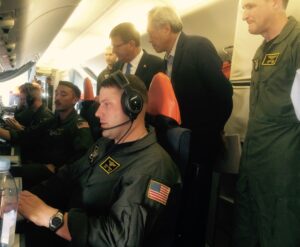
Defense Secretary Ashton Carter and Singaporean defence minister Ng Eng Hen watch the P-8 sensor crew at work.
View from the Crew
“The aircraft is a much more modern aircraft than the P-3,” Lt. Plum told me in a quick interview before takeoff. From a pilot’s perspective, she said, “this is a full glass cockpit” — i.e. digital displays instead of dials and switches — “(with) up-to-date flight instruments. We have a lot of situational awareness tools we didn’t have, like we have traffic advisories, very nice weather radar.”
“Autopilot,” added Lt. Mark Baden, the Tactical Coordination Officer (TACCO) who heads the sensor crew on Lt. Plum’s aircraft.
“Well, we had autopilot in the P-3, it just didn’t work,” Plum said.
“From the back’s perspective, the software interface with all the sensors is a lot better on the P-8,” Baden said. “There are more radios on this plane, and I would say the fidelity is much higher on this plane as far as the systems working.”
“The P-3 is extremely capable,” Baden hastened to say, “but it’s not interfaced as well.” The P-3 is a 1960s analog aircraft on which have been layered forty years of upgrades, while the P-8 is a fresh start and all-digital from the beginning.
“A lot of the equipment is the same and a lot of the capabilities are very similar,” he said, but in the P-3, the older, clunkier equipment takes up space throughout the plane, with operators wedged in where they’ll fit. By contrast, thanks to modern digital technology, the P-8’s interior is clean and uncluttered, with the sensor operators and TACCOs sitting in a single row where they can easily compare notes or look at each others’ high-resolution displays.
“Can you take it?” one operator asked his neighbor with a laugh, quickly handing over control of a sensor so he could focus on explaining the system to Carter and Ng. That pass wouldn’t have been so easy with the P-3 controls and layout.
The P-3 also had a reputation for making its crew frequently throw up during rough rides. Not so the P-8. “It’s a smoother aircraft,” said Plum. In fact, it’s the same airframe as a commercial passenger jet, the 737. “It’s a much nicer smoother ride and it’s quieter as well.”
Smooth and quiet. That’s just how the Singaporeans hope the P-8’s deployment to their city-state will go, without riling the geopolitical waters with their giant neighbor.
“The US presence… for the past seven decades has provided conditions of stability,” Ng said. “At the same time we recognize that situations change, that China is rising, and all of us agree that it’s not a zero-sum game….There’s no question of containment.”
In a time of heightened tensions in the South China Sea, however, the P-8 is also good to have around for when things arent that smooth.
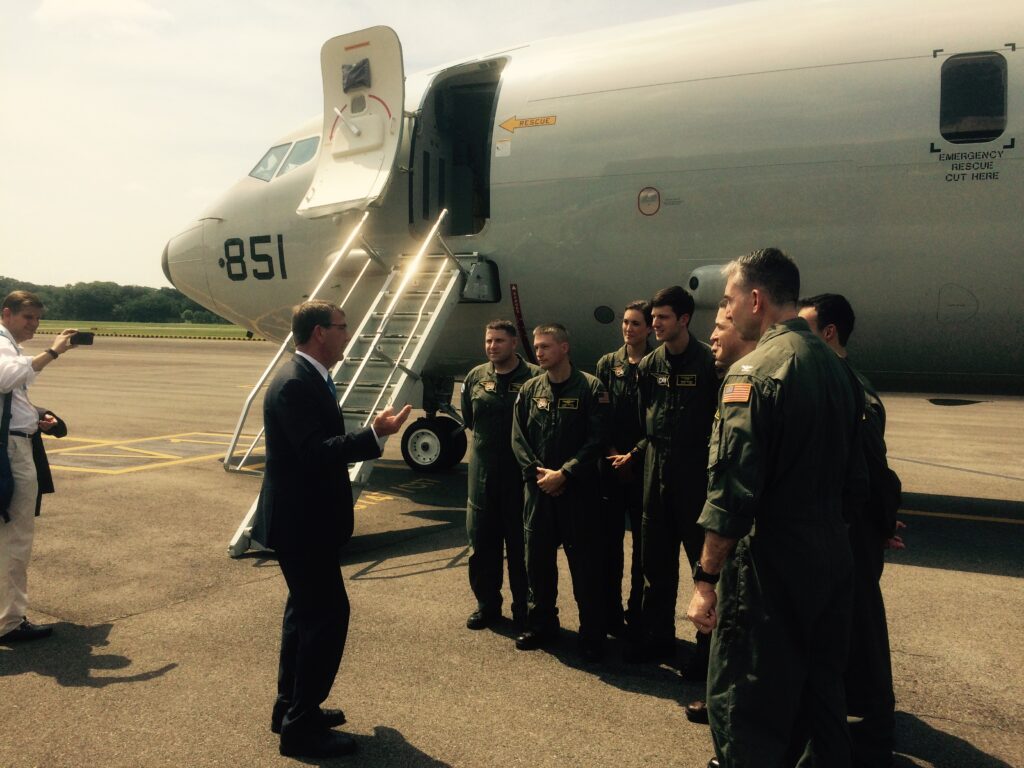
Defense Secretary Ashton Carter thanks the crew of the P-8 Poseidon which he flew on out of Singapore. (Pentagon press secretary Peter Cook is at far left).
Subscribe to our newsletter
Promotions, new products and sales. Directly to your inbox.
